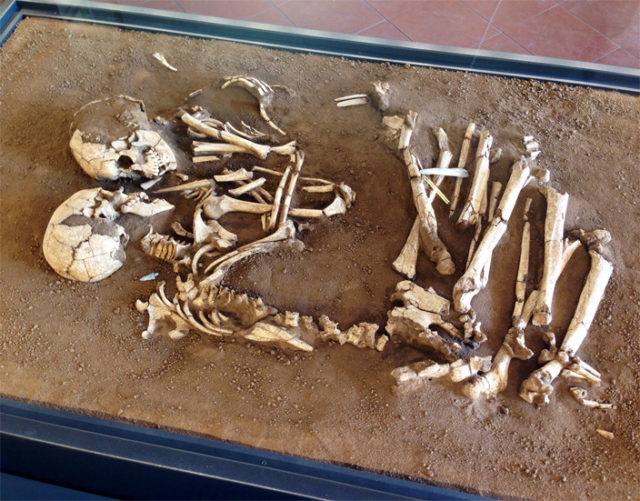Imagine a couple, their hands intertwined, faces gazing into each other’s eyes, frozen in time for over 6,000 years. This poignant scene was unveiled in 2007 near Mantua, Italy, when archaeologists discovered the “Lovers of Valdaro,” two Neolithic skeletons locked in an eternal embrace. This remarkable find not only offers a glimpse into the lives of our ancient ancestors but also speaks volumes about the timeless nature of love and connection.
The discovery of the Lovers of Valdaro occurred during a routine excavation in a gravel pit. As the archaeologists carefully unearthed the skeletal remains, they were struck by the intimate positioning of the two individuals. Their hands were clasped together, and their bodies were oriented in such a way that suggested a deep emotional bond. This extraordinary arrangement has led many to speculate about the nature of their relationship, igniting the imaginations of historians, anthropologists, and romantics alike.
Dating back to around 4,000 BCE, the Lovers of Valdaro belong to the Neolithic period, a time characterized by the advent of agriculture and settled living. During this era, human societies were undergoing significant transformations, moving from nomadic lifestyles to more complex social structures. The love story of these two individuals provides a powerful counterpoint to the often harsh realities of survival in a prehistoric world. It reminds us that, even in challenging times, the human capacity for affection and connection endures.
The physical evidence surrounding the skeletons also offers intriguing insights into the lives of the Lovers. Archaeologists discovered various artifacts and tools alongside the remains, suggesting that they were part of a community engaged in farming and craftsmanship. Additionally, the burial site was marked by care and attention, indicating that these individuals were cherished members of their society. This further emphasizes the significance of their relationship, as they were likely mourned and remembered by their peers.
The Lovers of Valdaro have since become an emblem of enduring love, inspiring artists, writers, and couples around the world. Their story resonates because it transcends the boundaries of time and culture, illustrating that love is a universal experience. In a world where relationships can often feel fleeting, the image of these two individuals locked in an embrace serves as a poignant reminder of the power of love to transcend even death.
Moreover, the discovery has spurred interest in the study of Neolithic societies and their beliefs surrounding love and relationships. Researchers have examined burial practices, social structures, and the significance of romantic partnerships in ancient cultures. The Lovers of Valdaro challenge us to reconsider our understanding of love in the past, suggesting that such emotional bonds were valued even thousands of years ago.
As the years go by, the fascination with the Lovers of Valdaro continues to grow. They have captured the hearts of many, becoming a symbol of eternal love that resonates with people of all ages. Their story invites us to reflect on our own relationships, encouraging us to cherish the connections we have with those we hold dear.
In conclusion, the discovery of the Lovers of Valdaro is not merely an archaeological find; it is a window into the human experience. Their intertwined hands and gazes locked in time remind us that love knows no bounds. It is a force that can defy the passage of time, connecting us to our ancestors and inspiring future generations. The Lovers of Valdaro, frozen in their eternal embrace, continue to tell a story that transcends the ages, a testament to the enduring power of love.









